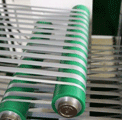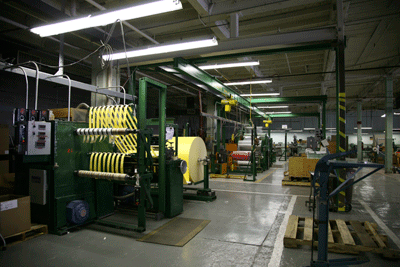Slitting/Rewinding | Trim Loss as Low as 3%
- Published: March 15, 2012
Reducing waste is always a smart idea. When “waste” happens to be your material and product, it is as much a matter of real dollars to you as it is “waste” and trim loss to your customer. That’s why Metlon Corp. has developed an internal process to reduce customers’ waste/trim loss to less than 5% and many times as little as 3%. The process began as far back as 1978, which was long before ISO 9000 certification, and certainly before the recent economic woes.
 Metlon Corp., the Cranston, RI-based contract converter that specializes in tight tolerances and narrow width slitting, began in 1947 by slitting the then-fashionable metallic yarns in widths down to 0.0156 in. At that time, its in-house manufacturing required only a few notes to maintain quality. Waste was not an issue. By the early 1970s, the slitting technology and expertise used in narrow width slitting of metallic yarns was repurposed for precision slitting for the trade, particularly for customers with unique needs, often expensive materials, and stringent demands.
Metlon Corp., the Cranston, RI-based contract converter that specializes in tight tolerances and narrow width slitting, began in 1947 by slitting the then-fashionable metallic yarns in widths down to 0.0156 in. At that time, its in-house manufacturing required only a few notes to maintain quality. Waste was not an issue. By the early 1970s, the slitting technology and expertise used in narrow width slitting of metallic yarns was repurposed for precision slitting for the trade, particularly for customers with unique needs, often expensive materials, and stringent demands.
Metlon quickly realized how accuracy factored into the entire process, not only for the accuracy of its equipment but accounting for many pertinent job details. Thus began the rudimentary checklist that has evolved for decades and has continued to produce savings for both the client and the converter.
Narrow Width Slitting
Wayne Etchells, executive VP, doesn’t mind talking about the material wasted in a customer’s job. It’s so minimal. Edge loss is integral to every converter’s job but in varying amounts. He readily acknowledges that Metlon’s very low percentage of waste loss results from two side edges, narrow edges, of any material it cuts. He also admits that those consistent results are inherent in and a direct consequence of narrow width slitting – the very niche that Metlon has carved for itself.
 “While waste loss is over and above trim loss, mathematically, we have an inherent advantage on trim loss,” Etchells comments nonchalantly. He calculates one example: “Cutting six-inch material into one-quarter inch would yield 24 cuts with no edge trim. The two outside cuts cannot be accurate; they cannot be held to a tight tolerance. Instead, Metlon would set up 23 cuts, with one-eighth inch off each end, equaling a trim loss on this job of 4.2%.
“While waste loss is over and above trim loss, mathematically, we have an inherent advantage on trim loss,” Etchells comments nonchalantly. He calculates one example: “Cutting six-inch material into one-quarter inch would yield 24 cuts with no edge trim. The two outside cuts cannot be accurate; they cannot be held to a tight tolerance. Instead, Metlon would set up 23 cuts, with one-eighth inch off each end, equaling a trim loss on this job of 4.2%.
"On the other hand, again governed by the width of the material, if a client sent us 18-inch-wide material, wanting it cut in 1-inch widths, this would equal 18 cuts with no trim. In order to get edge trim, you must eliminate one cut or a drop to 17 cuts. You have effectively lost one full inch, based on one-half inch on each side. Therefore, that one inch scrap translates into a 5.5% edge trim loss. A two-inch cut makes it worse, doubling the loss to 11%.”
To help customers, Metlon makes suggestions whenever appropriate. In the above example, Metlon would suggest that if the customer’s own job allowed, sending them a 17-3/8 in. wide material to slit would reduce the trim to 3/8 in. and reduce the total trim loss to 2.2%—a considerable difference from the 5.5% loss taken from the 18-in. roll.
Initially, Etchells accounts for the differential among converters’ material trim losses by using quick mathematical calculations and by contrasting the variability in required slitting widths.
However, it is the tight control that Metlon maintains over every facet of every job, encompassing far more than the relative cutting widths, that fully accounts for the better performance overall. Reducing loss, beyond anticipated trim loss, is the result of Metlon’s dynamic process and synergy: effective communications, operations, and documentation. At Metlon, everyone is accountable for every job; an objective system of checks and cross checks keeps it balanced and outcome-oriented.
Tight Controls
Metlon has established internal specifications for all jobs, plus additional space to detail customers’ highly specialized instructions and job specifications. This is the basis for an entire system that ensures that fewer cuts go bad. Cut quality, slit widths, and tolerances of the slit widths are standard items. All are measured and recorded at the start of each job and monitored through to the end of the job. Formulated prior to the creation of ISO 9000 certification, Metlon’s specifications continue to provide valid and reliable data, as well as outstanding results for the most demanding customers.

Once operators set up the slitter using the specifications, Metlon runs approximately 2 ft of material through the cutters before beginning to run the job, checking the cut quality for burrs, the accuracy of the slit width, the tolerance, and the slit edge quality. Approval sets the job in motion, and the Quality Control department then inspects the first finished set of production. For example, if one set of coils requires 24 cuts, that first set of 24 cuts is inspected again using Metlon’s criteria. Burrs, wind quality, and tension also are checked. Wind quality is inspected visually, and wind tension is tested as a hands-on, subjective check for tightness.
Additionally, inspectors verify that all customer specifications are being followed with respect to the labeling and splicing requirements. Customer supplied lot numbers, part numbers, and detailed tracking information are included in their QC inspection process. As a result, Metlon can trace all orders from the time the material comes in the door until the time it’s labeled and shipped—or drop shipped.
The process is thorough because the inspector’s form is lengthy. The put-up and the number of splices on the roll—if splices are allowed—are typical items. But, from purchase order number and part number to coil number, slit end letter to Metlon’s lot number, and more, Metlon focuses on every detail, every approval, and every note of correction, if modification is necessary. Lengthening that list, for example, might be plater: coil, plater: length, and plating date. These instructions are transferred from the incoming rolls when the material is supplied by the client, or it is on Metlon’s internal documents when it has acquired and stocked the rolls of material for the client.
There is a routine. Not only is the first finished set of each run of a job inspected, but Metlon also undertakes the same procedure at the beginning of each new day’s run if the job runs for multiple days. Results are re-validated by an inspector, who completes another set of the lengthy forms, and then cross checks that document against the previous days’ reports.
“The inspector usually has three options,“ according to Etchells, “including how to deal with problems if they are found. He may okay the job to run as is, if nothing is wrong. If he finds minor errors, and they are within customer’s specifications, he may continue to run the job, requiring another inspection at the end of the next set (i.e., tension adjustment would be an easy fix), or if he finds a major error, such as a problem with the actual cutting, he will then indicate on the form that the supervisor must be involved. The job would be stopped, corrected, and then begin again, with an inspector checking that new first set of cuts.”
Describing the hazards of a dull cutter if there were no inspections and checklist, Wayne notes that if an individual cutter were to go bad, causing nicks in the side of a cut roll, those nicks could go undetected if the operator didn’t see it, and if an inspector didn’t check it. “It would then yield one slit coil from every master roll that would be scrap. If it were a bad enough nick, it would ruin the entire production. Operators are supposed to be looking at both sides of every coil that they take off of the slitter, so that this would not happen, but the inspector—with a checklist in hand—just gives you extra assurance.”
Operators Monitor Slitters to prevent damage
Metlon insists that operators stay at the machine when the job is running. “It is against the company’s policy to leave the machine while the job is running,” Etchells says firmly. “It ensures the quality of the customer’s materials and it ensures the safety of our equipment,” calling it “critical” to the customer and to Metlon. He continues, “If an operator walks away from our slitters, within minutes serious damage could occur to the machine. If a single material cut broke, it could wrap into the cutting knives as they continued to turn. The cutters would then break, and that single piece would do significant damage to our machine, not to mention that the time spent on client’s work would be lost and the material ruined."
Perhaps it is an error that best exemplifies the inherent value of Metlon’s well-established process of checks and balances, particularly when the error occurred in a routine job. Typical of most manufacturing companies, Metlon has jobs that run every week—the same material slit from the same size roll at the same width.
Etchells explains that on one isolated occasion, Metlon ran one of the weekly orders in which 1100-1200-meter rolls became scrap 106 meters into the run, when a cutter became dull. The company didn’t continue because it would have ruined the entire roll; nevertheless, the customer couldn’t use the material produced from the dull cutter.
Using that same internal document enlisted for each customer, Metlon methodically examines the cut quality, measures the size of burr in the material, and monitors that the slit width held to a tight tolerance of ±0.001 in. It is noted that burrs are the more critical of the two measurements: +0.0002 in. or less.
At the time of the break, Etchells notes, “We had an excessive burr. At that point, we cut the material because the customer’s process will not allow the material to have splices in it."
Etchells looked at a year and half of Metlon’s track records of slitting this very expensive product and noted that it has slit 93,000 meters, with a total loss due to Metlon error over that time period of 0.1%. Accurately documented is that this is the only error caused by only one blade.
Nevertheless, Metlon assumes responsibility for the cost of their work; that is, what they would have charged to produce that cut. In view of the history, the error is only a bit more palatable to Etchells. Over the years, it is this discipline has helped Metlon to achieve that 5% or better waste loss. Of the process and the resulting track record, Etchells comments, “This reassures customers and builds instant credibility with new customers, even those with very challenging projects.
“While most know exactly what they need in terms of specs, some don’t have a list when they deliver their materials. In fact, some don’t deliver materials at all. They know only what they need to have as a finished product for their manufacturing process.” In that case, Metlon may purchase the material as well as set up the specifications for the job, run, and even warehouse the material for the customer’s future use. “We’re responsible for the material and the labor at that point,” notes Etchells. “Any error or loss along the way makes us entirely responsible, from set-up to shipping.”
At times, the cost of slitting is very low when compared to the customer’s raw material cost. Etchells cited an extreme example where the narrow width slitting labor cost could be $10/lb versus an estimated $192/lb for the raw material. Aware of Metlon’s expertise with the product, customers outline their specifications, and ask Metlon to purchase, store, slit, and deliver the finished product to them. Etchells then takes responsibility for the entire process. Recalling one example when the purchase was for a commercially available product with which Metlon was very familiar, he noted, “in this case, we knew we could save the client money.”
As precision narrow-width slitters, the company slits materials as narrow as 0.008 in., holding a tolerance of ±0.001 in. Most of the company’s converting work is among the industry’s narrowest and is in tightest tolerance, which means odds are they have the fewest problems and best results due to narrow-width slitting. Obtaining consistent results, without any other glitches that can happen from the front door to the back, is clearly a function of the well-integrated elements within Metlon’s process.
Converters of any width strip can enhance their performance by either establishing or tightening internal controls. Customers who participate in the process clearly have a better opportunity to reduce material loss and other material headaches.
To learn more about Metlon, click here.




